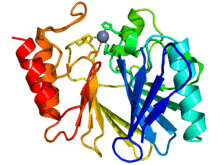Metallo-beta-lactamase protein fold
| Metallo-beta-lactamase superfamily | |||||||||
|---|---|---|---|---|---|---|---|---|---|
 Cartoon diagram of the crystallographic structure of a zinc metallo-beta-lactamase from bacillus cereus (N-terminus = blue, C-terminus = red) The catalytic zinc ion is depicted as a grey sphere.[1] | |||||||||
| Identifiers | |||||||||
| Symbol | Lactamase_B | ||||||||
| Pfam | PF00753 | ||||||||
| InterPro | IPR001279 | ||||||||
| SCOP | 1bmc | ||||||||
| SUPERFAMILY | 1bmc | ||||||||
| |||||||||
The metallo-beta-lactamase protein fold is a protein domain contained in class B beta-lactamases and a number of other proteins .[1] These proteins include thiolesterases, members of the glyoxalase II family, that catalyse the hydrolysis of S-D-lactoyl-glutathione to form glutathione and D-lactic acid and a competence protein that is essential for natural transformation in Neisseria gonorrhoeae and could be a transporter involved in DNA uptake. Except for the competence protein these proteins bind two zinc ions per molecule as cofactor.
Metallo-beta-lactamases are important enzymes because they are involved in the breakdown of antibiotics by antibiotic-resistant bacteria.[2] It is unclear whether metallo-beta-lactamase activity evolved once or twice within the superfamily; if twice, this would suggest structural exaptation.[3]
See also
References
- 1 2 PDB: 1bmc ; Carfi A, Pares S, Duée E, Galleni M, Duez C, Frère JM, Dideberg O (October 1995). "The 3-D structure of a zinc metallo-beta-lactamase from Bacillus cereus reveals a new type of protein fold". EMBO J. 14 (20): 4914–21. PMC 394593
 . PMID 7588620.
. PMID 7588620. - ↑ Shaw, Robert W; Kim, Sung-kun (November 2008). "Inhibition of metallo-β-lactamase". 7456274.
- ↑ Alderson R, Barker D, Mitchell JB (2014). "One origin for metallo-beta-lactamase activity, or two? An investigation assessing a diverse set of reconstructed ancestral sequences based on a sample of phylogenetic trees". J. Mol. Evol. 79: 117–29. doi:10.1007/s00239-014-9639-7. PMID 25185655.
This article incorporates text from the public domain Pfam and InterPro IPR001279